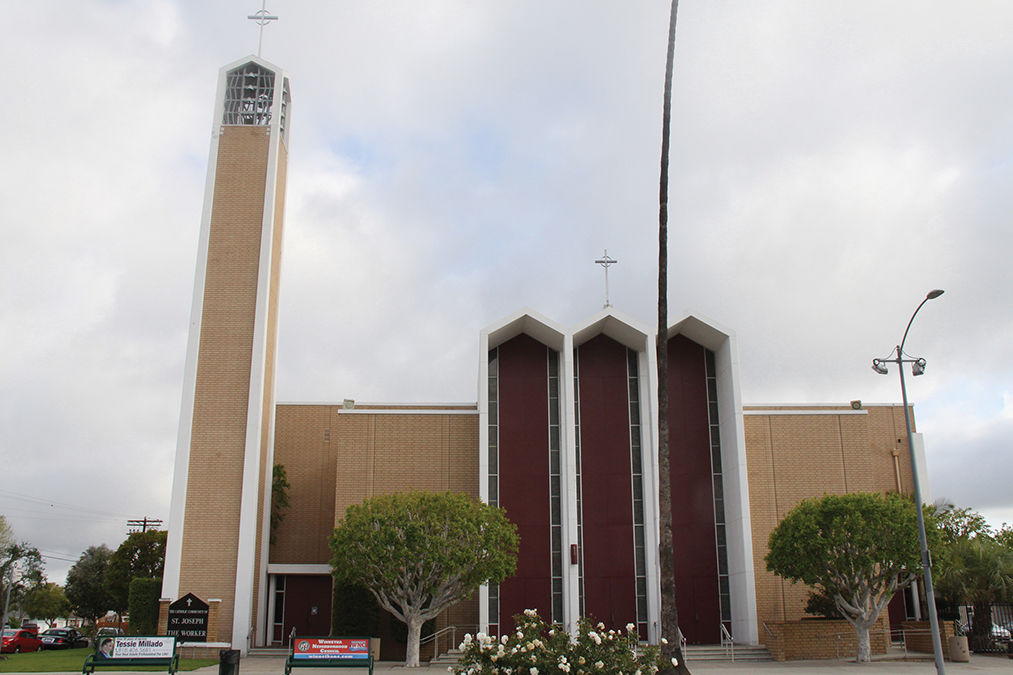In the beginning the Indians roamed freely in the western part of the valley, and then the land became a rancho, followed by wheat farms, settlers, more farmers and developers.
Part of the territory was named Owensmouth in 1912, anticipating water from the Owens River. In 1931 when Southern Pacific Railroad built a branch line through the area, the town was renamed Canoga Park after a small town in west-central New York.
(For 53 years the archdiocesan directory listed Canoga Park as the city for this parish. In the 2009 edition, the listing changed to Winnetka, the name chosen in 1922 to honor Charles Weeks, a poultry businessman and town founder who owned a farm in Winnetka, Illinois.)
Eight other parishes in the archdiocese are named for the foster father of Christ, but St. Joseph the Worker was chosen for the west San Fernando Valley parish, according to Cardinal Timothy Manning’s handwritten notes, “to recognize the new feast of St. Joseph the Worker established by Pope Pius XII in 1955.”
Pope Pius XII established the feast of St. Joseph the Worker to Christianize the concept of labor. In 1870, Pope Pius IX had proclaimed St. Joseph as patron of the universal church.
In fact, the Canoga Park/Winnetka parish may be the first in the world that honored the title of “worker” for St. Joseph, an appropriate choice given the influx of laborers in what was, at the time of its founding, a newly industrialized area of the valley. The initial group of 1,200 families came from the neighboring parishes of Our Lady of the Valley (to the west) and St. Catherine of Siena (to the east).
The founding pastor, Father (later Msgr.) Austin Greene from Worcester, Mass., a former Army chaplain in Korea, established the first parish rectory in a private home on Jumilla Street. He also formed 12 guilds to promote a strong relationship among families, and developed the nucleus for the Altar, Rosary and Holy Name Societies. The first Sunday Masses were celebrated in the auditorium of John A. Sutter Junior High School (across the street from the current church).
In March 1957, ground was broken for the first of the parish buildings. Sister Kathleen Joseph with several Sisters of St. Joseph of Carondelet arrived in September to staff the school, and in December the first Mass was celebrated in a structure that was later converted into an auditorium.
Cardinal James Francis McIntyre dedicated the new church on April 27, 1969. Of the design, the pastor said, “It is old enough to keep in touch with the past and modern enough to look to the future.” Behind the main altar was a mosaic figure of the risen Christ, the work of Isabel and Edith Piczek. Msgr. Greene, who served the parish for 25 years, died at age 74 in 1981.
Msgr. James Loughnane, a native of County Galway, Ireland, headed St. Joseph the Worker for 12 years, introducing several new ministries (including RCIA, Bible study and contemplative prayer) adding a Mass in Spanish and welcoming the Vietnamese community. Msgr. Loughnane was named a Protonotary Apostolic in 2005 and in 1993 appointed pastor of St. Denis in Diamond Bar.
During the 11-year term of Msgr. James Gehl, a native of Chicago, church improvements continued, but when the Northridge earthquake struck in 1994, all the liturgies were moved to the parish hall. Parishioners’ generous response helped complete repairs within a year and the new Peace Garden was dedicated to Msgr. Loughnane. Msgr. Gehl, a 1974 St. John’s seminary ordinand who previously headed the Office of Family Life, is now pastor of St. Euphrasia, Granada Hills.
Father Kevin Rettig, a native of Munich, Germany, was appointed pastor in 2005, the year he was incardinated in the archdiocese. He had been ordained in 1984 as a Norbertine priest (Father Hermann Joseph) and — fluent in German, Hungarian and Spanish — served as both associate and administrator at St. Stephen Church in Los Angeles for almost 20 years. He now oversees a 4,400-family parish whose service to church and community honors the foster father of Jesus.

